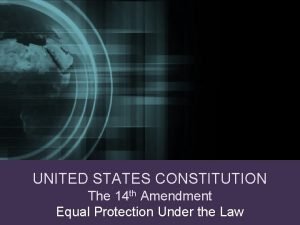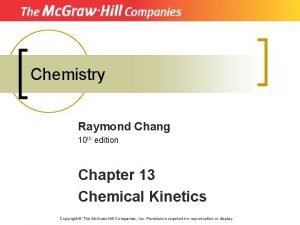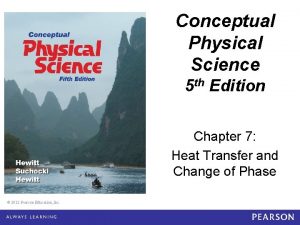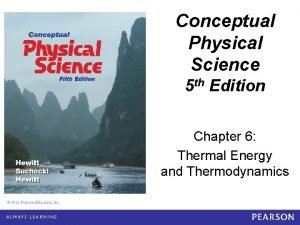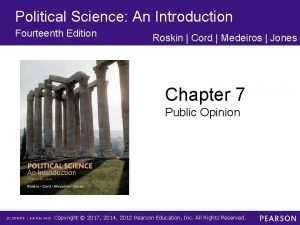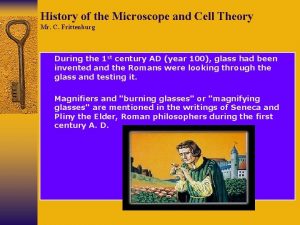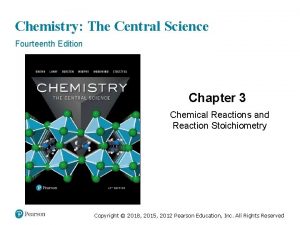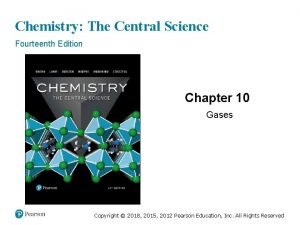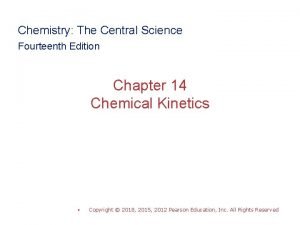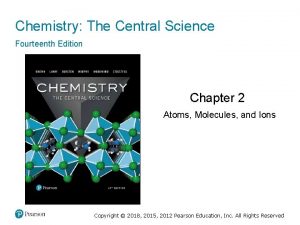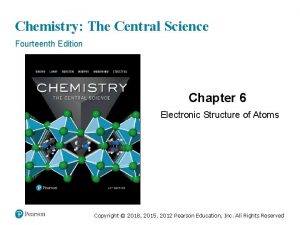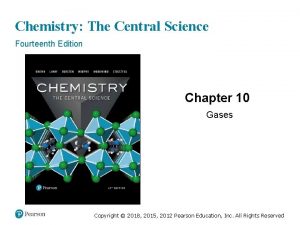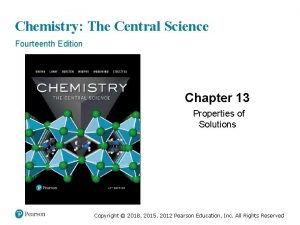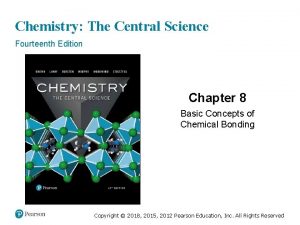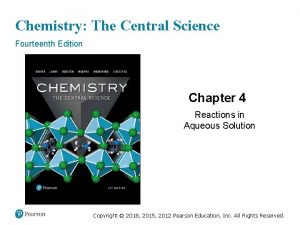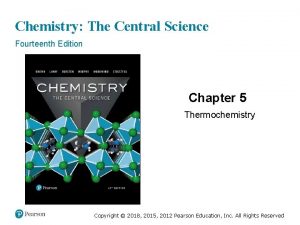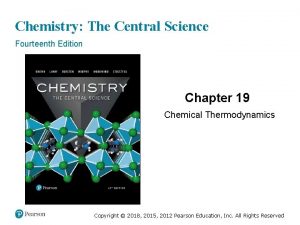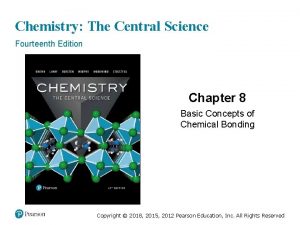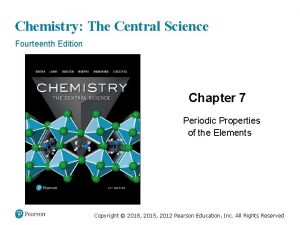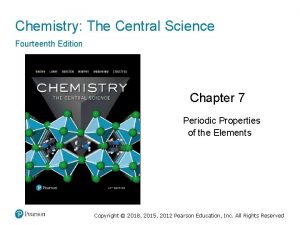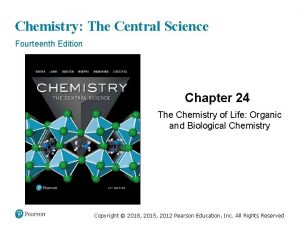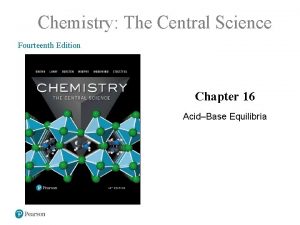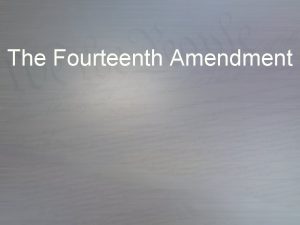Chemistry The Central Science Fourteenth Edition Chapter 11








































- Slides: 40

Chemistry: The Central Science Fourteenth Edition Chapter 11 Liquids and Intermolecular Forces Copyright © 2018, 2015, 2012 Pearson Education, Inc. All Rights Reserved

Intermolecular Forces • The attractions between molecules are not nearly as strong as the intramolecular attractions (bonds) that hold compounds together. • Many physical properties reflect intermolecular forces, like boiling points, melting points, viscosity, surface tension, and capillary action. Copyright © 2018, 2015, 2012 Pearson Education, Inc. All Rights Reserved

States of Matter • The fundamental difference between states of matter is the strength of the intermolecular forces of attraction. • Stronger forces bring molecules closer together. • Kinetic energy keeps them apart and moving. Remember that average kinetic energy is related to temperature! Copyright © 2018, 2015, 2012 Pearson Education, Inc. All Rights Reserved

Properties and State of Matter Table 11. 1 Characteristic Properties of the States of Matter Gas Liquid Solid Assumes both volume and shape of its container Assumes shape of portion of container it occupies Retains own shape and volume Expands to fill its container Does not expand to fill its container Is compressible Is virtually incompressible Flows readily Does not flow Diffusion within a gas occurs rapidly Diffusion within a liquid occurs slowly Diffusion within a solid occurs extremely slowly *The atoms in a solid are able to vibrate in place. As the temperature of the solid increases, the vibrational motion increases. Copyright © 2018, 2015, 2012 Pearson Education, Inc. All Rights Reserved

Relative Strength of Attractions Table 11. 2 Melting and Boiling Points of Representative Substances Force Holding Particles Together Substance Melting Point (K) blank Boiling Point (K) Chemical bonds blank Ionic bonds Lithium fluoride (Li. F) 1118 1949 Metallic bonds Beryllium (Be) 1560 2742 Covalent bonds Diamond (C) 3800 4300 Intermolecular forces blank Dispersion forces Nitrogen (N 2) 63 77 Dipole–dipole interactions Hydrogen chloride (HCl) 158 188 Hydrogen bonding Hydrogen fluoride (HF) 190 293 • Intermolecular attractions are weaker than bonds. • Hydrogen bonds are NOT chemical bonds. Copyright © 2018, 2015, 2012 Pearson Education, Inc. All Rights Reserved

Types of Intermolecular Force between Neutral Molecules • Weakest to strongest forces: – Dispersion forces (or London dispersion forces or induced dipole-induced dipole interactions) – Dipole–dipole forces – Hydrogen bonding (a special dipole–dipole force) Note: The first two types are also referred to collectively as van der Waals forces. Copyright © 2018, 2015, 2012 Pearson Education, Inc. All Rights Reserved

Dispersion Forces • A nonpolar particle (helium atoms below) can be temporarily polarized to create dispersion force. • The tendency of an electron cloud to distort is called its polarizability. Copyright © 2018, 2015, 2012 Pearson Education, Inc. All Rights Reserved

Factors That Affect Amount of Dispersion Force in a Molecule • Number of electrons in an atom (more electrons, more dispersion force) • Size of atom or molecule/molecular weight • Shape of molecules with similar masses (more compact, less dispersion force) Copyright © 2018, 2015, 2012 Pearson Education, Inc. All Rights Reserved

Polarizability and Boiling Point • If something is easier to polarize, it has a lower boiling point. • Remember: This means less intermolecular force (smaller molecule or atom: lower molecular weight, smaller size, fewer electrons). Copyright © 2018, 2015, 2012 Pearson Education, Inc. All Rights Reserved

Dipole–Dipole Interactions (1 of 2) • Polar molecules have a more positive and a more negative end—a dipole • The oppositely charged ends attract each other. Copyright © 2018, 2015, 2012 Pearson Education, Inc. All Rights Reserved

Dipole–Dipole Interactions (2 of 2) • For molecules of approximately equal mass and size, the more polar the molecule, the higher its boiling point. Copyright © 2018, 2015, 2012 Pearson Education, Inc. All Rights Reserved

Which Have a Greater Effect: Dipole– Dipole Interactions or Dispersion Forces? • If two molecules are of comparable size and shape, dipole–dipole interactions will likely be the dominating force. • If one molecule is much larger than another, dispersion forces will likely determine its physical properties. Copyright © 2018, 2015, 2012 Pearson Education, Inc. All Rights Reserved

What Does This Graph Show Us? • In a group, the period 3/4/5 elements have higher boiling points as the group member gets larger. • What happens with the period 2 elements? For group 4 A, the trend is continued. What about for the other groups? Copyright © 2018, 2015, 2012 Pearson Education, Inc. All Rights Reserved

Hydrogen Bonding • The dipole–dipole interactions experienced when H is bonded to N, O, or F are unusually strong. • We call these interactions hydrogen bonds. • A hydrogen bond is an attraction between a hydrogen atom attached to a highly electronegative atom and a nearby small electronegative atom in another molecule or chemical group. Copyright © 2018, 2015, 2012 Pearson Education, Inc. All Rights Reserved

What Forms Hydrogen Bonds? • Hydrogen bonding arises in part from the high electronegativity of nitrogen, oxygen, and fluorine. • These atoms interact with a nearly bare hydrogen nucleus (which contains one proton but NO inner electrons). Copyright © 2018, 2015, 2012 Pearson Education, Inc. All Rights Reserved

Ice Compared to Liquid Water • Hydrogen bonding makes the molecules farther apart in ice than in liquid water. Copyright © 2018, 2015, 2012 Pearson Education, Inc. All Rights Reserved

Ion–Dipole Interactions • Ion–dipole interactions are found in solutions of ions. • The strength of these forces is what makes it possible for ionic substances to dissolve in polar solvents, like water. Copyright © 2018, 2015, 2012 Pearson Education, Inc. All Rights Reserved

Determining Intermolecular Forces in a Substance Atoms Example: Ne, Ar Nonpolar molecules Example: BF 3, CH 4 Polar molecules without O H, NH, or HF groups Examples: HCl, CH 3 CN Dispersion forces (0. 1– 30 k. J/mol) ✔ ✔ ✔ Dipole–dipole interactions (2– 15 k. J/mol) blank ✔ ✔ blank Hydrogen bonding (10– 40 k. J/mol) blank ✔ blank Ion–dipole interactions (>50 k. J/mol) blank ✔ Type of Intermolecular interaction Polar molecules containing O H, NH, or HF groups Examples: H 2 O, N H 3 Ionic solids dissolved in polar liquids Examples: Na. Cl in H 2 O • Note that ALL chemicals exhibit dispersion forces. • The strongest force dictates the extent of attractions between molecules. Copyright © 2018, 2015, 2012 Pearson Education, Inc. All Rights Reserved

Generalizations about Relative Strengths of Intermolecular Forces 1) When two molecules have comparable molar masses and shapes, dispersion forces are roughly equal. 2) When two molecules have very different molar masses and there is no H-bonding, dispersion force determines the substance with stronger attractions. Copyright © 2018, 2015, 2012 Pearson Education, Inc. All Rights Reserved

Liquid Properties Affected by Intermolecular Forces • Boiling point (previously discussed) and melting point • Viscosity • Surface tension • Capillary action Copyright © 2018, 2015, 2012 Pearson Education, Inc. All Rights Reserved

Viscosity (1 of 2) • Resistance of a liquid to flow is called viscosity. • It is related to the ease with which molecules can move past each other. • Viscosity increases with stronger intermolecular forces and decreases with higher temperature. Copyright © 2018, 2015, 2012 Pearson Education, Inc. All Rights Reserved

Viscosity (2 of 2) Table 11. 3 Viscosities of a Series of Hydrocarbons at 20 degree Celsius Copyright © 2018, 2015, 2012 Pearson Education, Inc. All Rights Reserved

Surface Tension • Water acts as if it has a “skin” on it due to extra inward forces on its surface. • It causes water to “bead up” when in contact with nonpolar surfaces. • Those forces are called the surface tension. Copyright © 2018, 2015, 2012 Pearson Education, Inc. All Rights Reserved

Cohesion and Adhesion • Intermolecular forces that bind similar molecules to one another are called cohesive forces. • Intermolecular forces that bind a substance to a surface are called adhesive forces. • These forces are important in capillary action. Copyright © 2018, 2015, 2012 Pearson Education, Inc. All Rights Reserved

Capillary Action • The rise of liquids up narrow tubes is called capillary action. • Adhesive forces attract the liquid to the wall of the tube. • Cohesive forces attract the liquid to itself. • Water has stronger adhesive forces with glass; mercury has stronger cohesive forces with itself. Copyright © 2018, 2015, 2012 Pearson Education, Inc. All Rights Reserved

Phase Changes • Conversion from one state of matter to another is called a phase change. • Energy is either added or released in a phase change. • Phase changes: melting/freezing, vaporizing/condensing, subliming/depositing. Copyright © 2018, 2015, 2012 Pearson Education, Inc. All Rights Reserved

Energy Change and Change of State • The heat of fusion is the energy required to change a solid at its melting point to a liquid. • The heat of vaporization is the energy required to change a liquid at its boiling point to a gas. • The heat of sublimation is the energy required to change a solid directly to a gas. Copyright © 2018, 2015, 2012 Pearson Education, Inc. All Rights Reserved

Heating Curves • A graph of temperature vs. heat added is called a heating curve. • Within a phase, heat is the product of specific heat, sample mass, and temperature change. • The temperature of the substance does not rise during a phase change. • For the phase changes, the product of mass or moles and heat of fusion or vaporization is heat. Copyright © 2018, 2015, 2012 Pearson Education, Inc. All Rights Reserved

Supercritical Fluids (1 of 2) • Gases liquefy when pressure is applied. • The temperature beyond which a gas cannot be compressed is called its critical temperature. The pressure needed to compress the liquid at critical temperature is called critical pressure. • The state beyond this temperature is called a supercritical fluid. Copyright © 2018, 2015, 2012 Pearson Education, Inc. All Rights Reserved

Supercritical Fluids (2 of 2) Table 11. 5 Critical Temperatures and Pressures of Selected Substances Substance Critical Temperature (K) Critical Pressure (atm) Nitrogen, N 2 126. 1 33. 5 Argon, Ar 150. 9 48. 0 Oxygen, O 2 154. 4 49. 7 Methane, CH 4 190. 0 45. 4 Carbon dioxide, CO 2 304. 3 73. 0 Phosphine, PH 3 324. 4 64. 5 Propane, CH 3 CH 2 CH 3 370. 0 42. 0 Hydrogen sulfide, H 2 S 373. 5 88. 9 Ammonia, NH 3 405. 6 111. 5 Water, H 2 O 647. 6 217. 7 Copyright © 2018, 2015, 2012 Pearson Education, Inc. All Rights Reserved

Vapor Pressure (1 of 4) • At any temperature, some liquid molecules have enough energy to escape the surface and become a gas. • As the temperature rises, the fraction of molecules that have enough energy to break free increases. Copyright © 2018, 2015, 2012 Pearson Education, Inc. All Rights Reserved

Vapor Pressure (2 of 4) • As more molecules escape the liquid, the pressure they exert increases. • The liquid and vapor reach a state of dynamic equilibrium: Liquid molecules evaporate and vapor molecules condense at the same rate. Copyright © 2018, 2015, 2012 Pearson Education, Inc. All Rights Reserved

Vapor Pressure (3 of 4) • The boiling point of a liquid is the temperature at which its vapor pressure equals atmospheric pressure. • The normal boiling point is the temperature at which its vapor pressure is 760 torr. Copyright © 2018, 2015, 2012 Pearson Education, Inc. All Rights Reserved

Vapor Pressure (4 of 4) • The natural log of the vapor pressure of a liquid is inversely proportional to its temperature. • This relationship is quantified in the Clausius Clapeyron equation. Copyright © 2018, 2015, 2012 Pearson Education, Inc. All Rights Reserved

Phase Diagram • A phase diagram is a graph showing states of matter under conditions of temperature and pressure. • It also shows changes of state and the triple point and critical point. Copyright © 2018, 2015, 2012 Pearson Education, Inc. All Rights Reserved

Phase Diagram of Water • Note the high critical temperature and critical pressure due to the strong van der Waals forces. • Unusual feature for water: – The slope of the melting curve is negative (as the pressure is increased, the melting point decreases). Copyright © 2018, 2015, 2012 Pearson Education, Inc. All Rights Reserved

Phase Diagram of Carbon Dioxide • Unusual features for carbon dioxide: – Cannot exist in the liquid state at pressures below 5. 11 atm (triple point). – CO 2 sublimes at normal pressures. Copyright © 2018, 2015, 2012 Pearson Education, Inc. All Rights Reserved

Liquid Crystals (1 of 2) • Some substances do not go directly from the solid state to the liquid state. • In this intermediate state, liquid crystals have some traits of solids and some of liquids. • Molecules in liquid crystals have some degree of order. Copyright © 2018, 2015, 2012 Pearson Education, Inc. All Rights Reserved

Liquid Crystals (2 of 2) • In nematic liquid crystals, molecules are ordered in only one dimension, along the long axis. • In smectic liquid crystals, molecules are ordered in two dimensions, along the long axis and in layers. • In cholesteric liquid crystals, nematic-like crystals are layered at angles to each other. Copyright © 2018, 2015, 2012 Pearson Education, Inc. All Rights Reserved

Copyright © 2018, 2015, 2012 Pearson Education, Inc. All Rights Reserved
 Management fourteenth edition
Management fourteenth edition Chapter 1 chapter assessment the central science
Chapter 1 chapter assessment the central science Fourteenth amendment
Fourteenth amendment Summer of his fourteenth year poem
Summer of his fourteenth year poem Pericyclic
Pericyclic Organic chemistry third edition david klein
Organic chemistry third edition david klein Organic chemistry (3rd) edition chapter 2 problem 17s
Organic chemistry (3rd) edition chapter 2 problem 17s What is your favorite lesson
What is your favorite lesson Mis chapter 6
Mis chapter 6 Using mis (10th edition) 10th edition
Using mis (10th edition) 10th edition Rearranged most stable carbocation is
Rearranged most stable carbocation is Organic chemistry 2nd edition klein
Organic chemistry 2nd edition klein Introductory chemistry 4th edition
Introductory chemistry 4th edition Introductory chemistry 5th edition nivaldo j. tro
Introductory chemistry 5th edition nivaldo j. tro Introductory chemistry 5th edition nivaldo j. tro
Introductory chemistry 5th edition nivaldo j. tro Nomenclature of ethers
Nomenclature of ethers Zumdahl chemistry, 9th edition notes
Zumdahl chemistry, 9th edition notes Organic chemistry third edition david klein
Organic chemistry third edition david klein General chemistry
General chemistry Drop in molecular views answer key
Drop in molecular views answer key Chemistry by raymond chang 10th edition
Chemistry by raymond chang 10th edition Fifth edition chemistry a molecular approach
Fifth edition chemistry a molecular approach Klein organic chemistry 2nd edition
Klein organic chemistry 2nd edition Klein
Klein Ib organic chemistry functional groups
Ib organic chemistry functional groups Inorganic chemistry vs organic chemistry
Inorganic chemistry vs organic chemistry Biological science 6th edition
Biological science 6th edition Psychological science 5th edition
Psychological science 5th edition Conceptual physical science 5th edition
Conceptual physical science 5th edition Bimetallic strip
Bimetallic strip Conceptual physical science 5th edition
Conceptual physical science 5th edition The fundamentals of political science research 2nd edition
The fundamentals of political science research 2nd edition Political science 14th edition
Political science 14th edition Political science 14th edition
Political science 14th edition Science power 9 atlantic edition
Science power 9 atlantic edition Hát kết hợp bộ gõ cơ thể
Hát kết hợp bộ gõ cơ thể Slidetodoc
Slidetodoc Bổ thể
Bổ thể Tỉ lệ cơ thể trẻ em
Tỉ lệ cơ thể trẻ em Gấu đi như thế nào
Gấu đi như thế nào Glasgow thang điểm
Glasgow thang điểm


